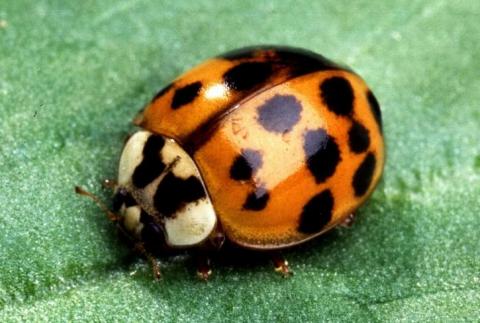How can I get rid of Asian ladybugs in my house?

As the days get shorter and nighttime temperatures drop, many people are starting to notice Asian ladybugs aggregating in or on their homes. While ladybugs are usually considered beneficial in the garden because they eat insect pests like aphids, they can be a nuisance in the fall when they invade buildings. Asian ladybugs are “overwintering” insects that hibernate as adults and spend the winter in protected places such as under tree bark or beneath the siding of buildings. Some insects accidentally make their way indoors and can be found crawling around windows, walls and ceilings. Fortunately, they are not dangerous to people, pets or the structure of the home and do not breed or lay eggs inside of buildings.
Habits and Description
Asian ladybugs were introduced to the United States from Asia. Some were purposefully released as a biological control for agricultural pests. Others may have traveled on freight coming from Asia. Since the 1990s they have become established throughout much of the United States. Unlike other introduced insects, Asian ladybugs do provide some benefits. Asian ladybugs prey on aphids, mealybugs, scales and other soft-bodied pest insects in fields, forests and gardens, similar to their native counterparts in North America. In general, they are considered valuable predators in the landscape.
Asian ladybugs are quite variable in appearance. Their coloration can range from tan to orange to red. Their wing covers are either unmarked or covered with as many as 22 black spots. Most individuals have a black M-shaped marking in the white area behind their heads, a feature that most easily distinguishes Asian ladybugs from other species.
Getting Rid of Asian Ladybugs
The best way to manage Asian ladybugs is to prevent them from getting inside the home in the first place. Remove air conditioners when they are no longer needed and take care to seal up cracks around windows and doors, particularly on the sunny southern and western sides of the house. Insects that get inside can be swept into a jar and released outdoors or sucked up with a vacuum cleaner (empty the vacuum bag promptly to prevent ladybugs from escaping). When ladybugs are disturbed, they often release an unpleasant odor and produce a yellowish staining fluid which can damage light colored rugs and upholstery. Staining is less likely to occur when vacuuming as opposed to sweeping them up. On rare occasions, Asian ladybugs may bite if picked up with bare hands. When threatened, they might use their chewing mouthparts to pinch the skin. These bites are not serious—the equivalent to the feeling of a pinprick—and can be avoided by wearing gloves.
Insecticides are not recommended for managing these pests as they work too slowly to control the problem and are toxic to people. Since lady bugs are beneficial predators, focus your energy on sealing up cracks where they might be getting into your home.
Some garden supply companies sell ladybug houses that are designed to provide hibernating habitat for ladybugs in the garden. While these houses might provide shelter for some ladybugs, they will not prevent ladybugs from coming into the home.
Several other insect species can invade homes in the fall but, similarly, they do not attack people or threaten homes. If you have Asian ladybugs or any other type of seasonal home-invading insect, do not panic. Once the temperatures go down, so will their activity.
Related Resource(s)
Do you love learning about stuff like this?
SUBSCRIBE TO Granite State Gardening newsletter
Got questions? The UNH Extension Yard and Garden Infoline offers practical help finding answers for your yard and garden questions.
Call toll free at 1-877-398-4769, Monday to Friday, 9 a.m. to 2 p.m., or fill out webform.
